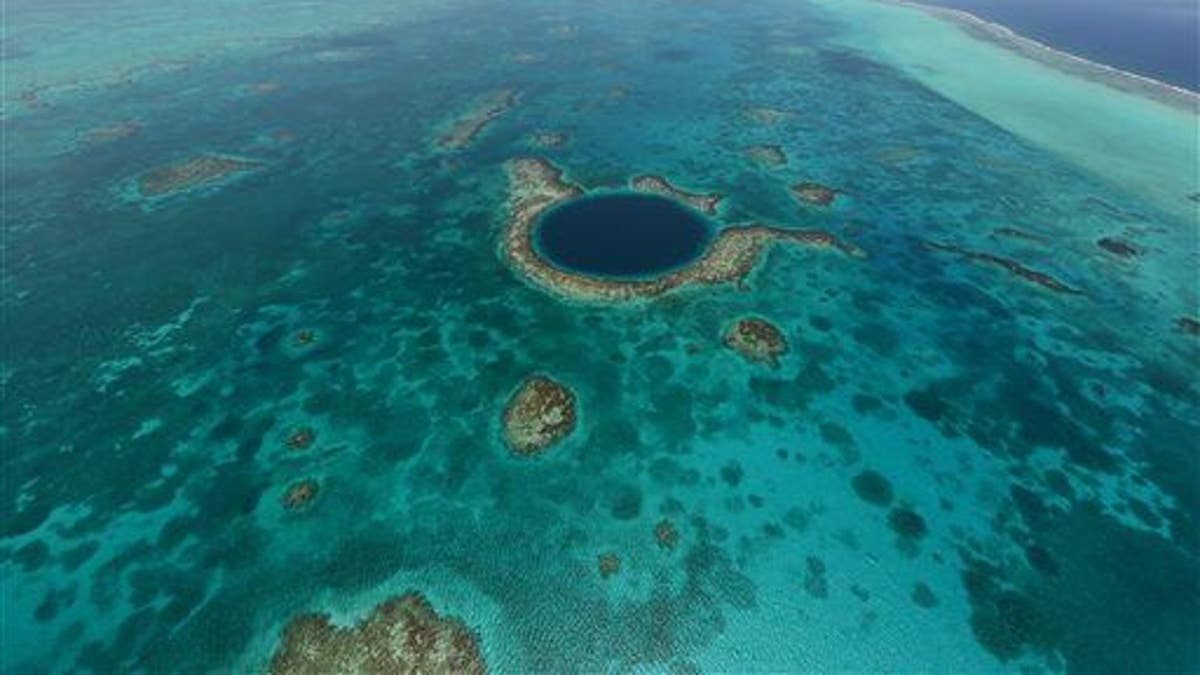
This undated image provided by the Belize Tourist Board shows an aerial view of the Great Blue Hole, a popular diving site that's part of Belize's barrier reef. (AP Photo/Belize Tourist Board)
A giant underwater sinkhole located off the coast of Belize has grown in popularity over the years — for its size, deep blue colors and the mysteries that lie hundreds of feet below the ocean surface.
The tourist attraction, which has been dubbed the "Great Blue Hole," is a collapsed cave that measures approximately 984 feet across and 410 feet deep. NASA scientist Glyn Collinson once described it as the "deepest, deep blue hole imaginable."
So, it's no surprise scientists are eager to learn more about the crater, which has spurred rumors of sea monsters and bizarre creatures that live inside. In November 2018, researchers with Vancouver-based Aquatica Submarines sent a three-person submarine to the site to explore the bottom of the Great Blue Hole for the first time.
MASSIVE SEA CREATURE THAT WASHED UP IN CALIFORNIA IS ONE OF THE WORLD'S RAREST, SCIENTISTS SAY
"Preserved from the disturbance of time, and isolated in the darkness, the hole holds clues to a very natural part of our planet’s life cycle. It’s these terraces and stalactites we set out to map," Erika Bergman, chief submarine pilot on the recent expedition, explained in a recent blog post.
The team conducted more than 20 dives into the large sinkhole from Nov. 27 to Dec. 13, taking videos and 3-D images during each trip, Aquatica Submarines said in a news release. They even completed a two-hour live broadcast from the deep blue waters that was featured on The Discovery Channel.
One of the biggest findings of the trip was the discovery of "mysterious tracks" in the sand roughly 350 feet below the surface.
In an interview with CNN Travel, Bergman said the "unidentifiable" tracks remain "open to interpretation."
PHOTO OF FIERY BUBBLE THAT STRETCHES 65 FEET IN THE AIR STUNS THE INTERNET
Bergman, however, wrote in a blog post that they were located near an area researchers labeled the "Conch Graveyard," where they witnessed hundreds of dead conch that likely suffocated after becoming trapped in the oxygen-deprived base of the Blue Hole.
"Presumably, unsuspecting conchs (or other conch shell inhabitants) have been going just a little too close to the edge and falling into the hole at this entrance by the thousands. We can see each conch with little tracks back up the hill trying to escape, then a slide mark where it slid back down after presumably being asphyxiated in the anoxic environment," Bergman explained.
Roughly 300 feet below sea level, Bergman said the crew detected toxic hydrogen sulfide gas.
"There is no circulation in or out of the hole, and our onboard CTD and dissolved oxygen sensor revealed what we had predicted, the bottom is completely anoxic. There’s not a drop of oxygen below the H2S layer," Bergman described, noting that sargassum seaweed could be a contributing factor.
As far as billionaire business magnate and Virgin founder Richard Branson – who joined the expedition – is concerned, there is no mythical monster hiding in the depths of the Blue Hole.
"The real monsters facing the ocean are climate change and plastic," Branson said, according to Newsweek. "Sadly, we saw plastic bottles at the bottom of the hole, which is a real scourge of the ocean. We’ve all got to get rid of single-use plastic.”




















